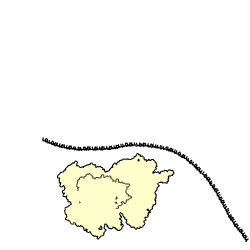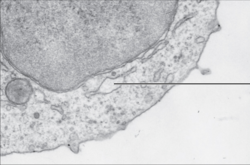Endoplasmic reticulum facts for kids
Quick facts for kids Cell biology |
|
|---|---|
| Animal cell diagram | |

Components of a typical animal cell:
|
The endoplasmic reticulum (ER) is a very important organelle found inside eukaryotic cells. Think of it as a cell's factory and highway system all in one. It helps make and move important molecules like proteins and lipids (fats).
The name sounds complicated, but it's easy to break down. Endoplasmic means "within the cytoplasm," and reticulum is Latin for "little net." So, it's a little net inside the cell's cytoplasm!
The ER is a network of tiny tubes and sacs that is connected to the outer membrane of the cell's nucleus. It has two main parts that look and work differently: the rough endoplasmic reticulum (RER) and the smooth endoplasmic reticulum (SER). Most cells have both types, but not all. For example, red blood cells don't have an ER at all.
Scientists first saw the ER's lacy structure with an electron microscope in 1945. They were amazed to find this busy network inside the cell.
Contents
The Two Types of ER

The ER is made of a network of membranes that form sacs and tubes. These sacs are called cisternae. The whole network is held in place by the cell's internal support structure, the cytoskeleton.
The amount of rough and smooth ER in a cell can change. Depending on what the cell needs to do, it can make more of one type and less of the other. Let's look at the two types more closely.
Rough ER: The Protein Factory
The rough endoplasmic reticulum (RER) gets its name because its surface is covered with tiny dots called ribosomes. These ribosomes make the RER look bumpy or "rough" under a microscope. Ribosomes are the cell's protein-making machines.
The RER's main job is to make and process proteins that will be sent out of the cell or to other organelles. Here's how it works:
- A ribosome starts making a protein.
- If the protein has a special "address tag," the ribosome attaches to the RER.
- The new protein is pushed inside the RER, where it gets folded into the correct 3D shape.
- The RER also adds sugars or other molecules to the protein, like decorating it for its job.
Once the proteins are ready, the RER pinches off small bubbles of its membrane, called transport vesicles. These vesicles carry the proteins to the Golgi apparatus, which is like the cell's post office, for more processing and shipping.
Smooth ER: The Detox and Lipid Specialist
The smooth endoplasmic reticulum (SER) does not have ribosomes on its surface, which is why it looks "smooth." It has a different set of jobs from the RER.
The main functions of the SER include:
- Making lipids: It produces important fats, phospholipids (for cell membranes), and steroids. Cells in the ovaries and testes, which make steroid hormones, have a lot of SER.
- Detoxification: The SER helps break down harmful substances. Liver cells, which clean the blood, are packed with SER to help with this job.
- Storing calcium: It stores calcium ions, which are very important for many cell activities, especially in muscle cells.
A Special Kind of Smooth ER in Muscles
In muscle cells, the smooth ER has a special name: the sarcoplasmic reticulum (SR). Its main job is to store huge amounts of calcium ions.
When a nerve signal tells a muscle to contract, the SR releases these calcium ions. The calcium causes the muscle fibers to shorten, making the muscle move. The SR then pumps the calcium back in, allowing the muscle to relax. This process is key to how we move our bodies.
The ER's Main Jobs Summarized
The endoplasmic reticulum is a busy place with many important jobs that keep the cell running smoothly. Here are its main functions:
- Protein Production and Quality Control: The rough ER makes new proteins and acts like a quality control inspector. It has special helper proteins called chaperones that help new proteins fold into their perfect 3D shape. Only correctly folded proteins are allowed to leave the ER.
- Transporting Molecules: The ER is the starting point for the cell's "shipping department." It packages proteins and lipids into vesicles that travel to the Golgi apparatus and other destinations inside or outside the cell.
- Making Lipids and Steroids: The smooth ER is the cell's main factory for producing lipids, phospholipids for membranes, and steroid hormones.
- Detoxification: The smooth ER helps protect the cell by breaking down harmful chemicals, making them safe to remove from the body.
What Happens When the ER Gets Stressed?
Just like people, cells can get stressed. The ER can become stressed if it has to work too hard, for example, if too many proteins are being made and they don't fold correctly. This is called "ER stress."
When the ER is stressed, it sends out alarm signals in the cell. The cell then tries to fix the problem by slowing down protein production and making more helper chaperone proteins. This process is called the unfolded protein response.
If the stress is too much or lasts too long, the ER can't keep up. This can damage the cell and may be linked to certain health problems. Scientists are studying ER stress to better understand how cells stay healthy.
See also
 In Spanish: Retículo endoplasmático para niños
In Spanish: Retículo endoplasmático para niños
- Ribosome-associated vesicle



